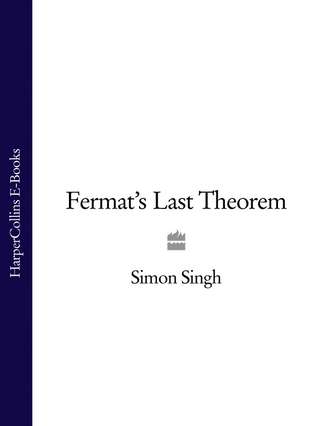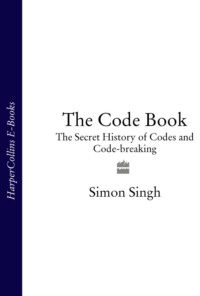
Полная версия
Fermat’s Last Theorem
Iamblichus, the fourth-century scholar who wrote nine books about the Pythagorean sect, describes how Pythagoras came to discover the underlying principles of musical harmony:
Once he was engrossed in the thought of whether he could devise a mechanical aid for the sense of hearing which would prove both certain and ingenious. Such an aid would be similar to the compasses, rules and optical instruments designed for the sense of sight. Likewise the sense of touch had scales and the concepts of weights and measures. By some divine stroke of luck he happened to walk past the forge of a blacksmith and listened to the hammers pounding iron and producing a variegated harmony of reverberations between them, except for one combination of sounds.
According to Iamblichus, Pythagoras immediately ran into the forge to investigate the harmony of the hammers. He noticed that most of the hammers could be struck simultaneously to generate a harmonious sound, whereas any combination containing one particular hammer always generated an unpleasant noise. He analysed the hammers and realised that those which were harmonious with each other had a simple mathematical relationship – their masses were simple ratios or fractions of each other. That is to say that hammers half, two-thirds or three-quarters the weight of a particular hammer would all generate harmonious sounds. On the other hand, the hammer which was generating disharmony when struck along with any of the other hammers had a weight which bore no simple relationship to the other weights.
Pythagoras had discovered that simple numerical ratios were responsible for harmony in music. Scientists have cast some doubt on Iamblichus’ account of this story, but what is more certain is how Pythagoras applied his new theory of musical ratios to the lyre by examining the properties of a single string. Simply plucking the string generates a standard note or tone which is produced by the entire length of the vibrating string. By fixing the string at particular points along its length, it is possible to generate other vibrations and tones. Crucially, harmonious tones only occur at very specific points. For example, by fixing the string at a point exactly half-way along it, plucking generates a tone which is one octave higher and in harmony with the original tone. Similarly, by fixing the string at points which are exactly a third, a quarter or a fifth of the way along it, other harmonious notes are produced. However, by fixing the string at a point which is not a simple fraction along the length of the whole string, a tone is generated which is not in harmony with the other tones.
Pythagoras had uncovered for the first time the mathematical rule which governs a physical phenomenon and demonstrated that there was a fundamental relationship between mathematics and science. Ever since this discovery scientists have searched for the mathematical rules which appear to govern every single physical process and have found that numbers crop up in all manner of natural phenomena. For example, one particular number appears to guide the lengths of meandering rivers. Professor Hans-Henrik Stølum, an earth scientist at Cambridge University, has calculated the ratio between the actual length of rivers from source to mouth and their direct length as the crow flies. Although the ratio varies from river to river, the average value is slightly greater than 3, that is to say that the actual length is roughly three times greater than the direct distance. In fact the ratio is approximately 3.14, which is close to the value of the number π, the ratio between the circumference of a circle and its diameter.
The number π was originally derived from the geometry of circles and yet it reappears over and over again in a variety of scientific circumstances. In the case of the river ratio, the appearance of π is the result of a battle between order and chaos. Einstein was the first to suggest that rivers have a tendency towards an ever more loopy path because the slightest curve will lead to faster currents on the outer side, which will in turn result in more erosion and a sharper bend. The sharper the bend, the faster the currents on the outer edge, the more the erosion, the more the river will twist, and so on. However, there is a natural process which will curtail the chaos: increasing loopiness will result in rivers doubling back on themselves and effectively short-circuiting. The river will become straighter and the loop will be left to one side forming an ox-bow lake. The balance between these two opposing factors leads to an average ratio of π between the actual length and the direct distance between source and mouth. The ratio of π is most commonly found for rivers flowing across very gently sloping plains, such as those found in Brazil or the Siberian tundra.
Pythagoras realised that numbers were hidden in everything, from the harmonies of music to the orbits of planets, and this led him to proclaim that ‘Everything is Number’. By exploring the meaning of mathematics, Pythagoras was developing the language which would enable him and others to describe the nature of the universe. Henceforth each breakthrough in mathematics would give scientists the vocabulary they needed to better explain the phenomena around them. In fact developments in mathematics would inspire revolutions in science.
As well as discovering the law of gravity, Isaac Newton was a powerful mathematician. His greatest contribution to mathematics was his development of calculus, and in later years physicists would use the language of calculus to better describe the laws of gravity and to solve gravitational problems. Newton’s classical theory of gravity survived intact for centuries until it was superseded by Albert Einstein’s general theory of relativity, which developed a more detailed and alternative explanation of gravity. Einstein’s own ideas were only possible because of new mathematical concepts which provided him with a more sophisticated language for his more complex scientific ideas. Today the interpretation of gravity is once again being influenced by breakthroughs in mathematics. The very latest quantum theories of gravity are tied to the development of mathematical strings, a theory in which the geometrical and topological properties of tubes seem to best explain the forces of nature.
Of all the links between numbers and nature studied by the Brotherhood, the most important was the relationship which bears their founder’s name. Pythagoras’ theorem provides us with an equation which is true of all right-angled triangles and which therefore also defines the right angle itself. In turn, the right angle defines the perpendicular, i.e. the relation of the vertical to the horizontal, and ultimately the relation between the three dimensions of our familiar universe. Mathematics, via the right angle, defines the very structure of the space in which we live.

Figure 1. All right-angled triangles obey Pythagoras’ theorem.
It is a profound realisation and yet the mathematics required to grasp Pythagoras’s theorem is relatively simple. To understand it, simply begin by measuring the length of the two short sides of a right-angled triangle (x and y), and then square each one (x2, y2). Then add the two squared numbers (x2 + y2) to give you a final number. If you work out this number for the triangle shown in Figure 1, then the answer is 25.
You can now measure the longest side z, the so-called hypotenuse, and square this length. The remarkable result is that this number z2 is identical to the one you just calculated, i.e. 52 = 25. That is to say,
In a right-angled triangle the square on the hypotenuse is equal to the sum of the squares on the other two sides.
Or in other words (or rather symbols):

This is clearly true for the triangle in Figure 1, but what is remarkable is that Pythagoras’ theorem is true for every right-angled triangle you can possibly imagine. It is a universal law of mathematics, and you can rely on it whenever you come across any triangle with a right angle. Conversely if you have a triangle which obeys Pythagoras’ theorem, then you can be absolutely confident that it is a right-angled triangle.
At this point it is important to note that, although this theorem will forever be associated with Pythagoras, it was actually used by the Chinese and the Babylonians one thousand years before. However, these cultures did not know that the theorem was true for every right-angled triangle. It was certainly true for the triangles they tested, but they had no way of showing that it was true for all the right-angled triangles which they had not tested. The reason for Pythagoras’ claim to the theorem is that it was he who first demonstrated its universal truth.
But how did Pythagoras know that his theorem is true for every right-angled triangle? He could not hope to test the infinite variety of right-angled triangles, and yet he could still be one hundred per cent sure of the theorem’s absolute truth. The reason for his confidence lies in the concept of mathematical proof. The search for a mathematical proof is the search for a knowledge which is more absolute than the knowledge accumulated by any other discipline. The desire for ultimate truth via the method of proof is what has driven mathematicians for the last two and a half thousand years.
Absolute Proof
The story of Fermat’s Last Theorem revolves around the search for a missing proof. Mathematical proof is far more powerful and rigorous than the concept of proof we casually use in our everyday language, or even the concept of proof as understood by physicists or chemists. The difference between scientific and mathematical proof is both subtle and profound, and is crucial to understanding the work of every mathematician since Pythagoras.
The idea of a classic mathematical proof is to begin with a series of axioms, statements which can be assumed to be true or which are self-evidently true. Then by arguing logically, step by step, it is possible to arrive at a conclusion. If the axioms are correct and the logic is flawless, then the conclusion will be undeniable. This conclusion is the theorem.
Mathematical theorems rely on this logical process and once proven are true until the end of time. Mathematical proofs are absolute. To appreciate the value of such proofs they should be compared with their poor relation, the scientific proof. In science a hypothesis is put forward to explain a physical phenomenon. If observations of the phenomenon compare well with the hypothesis, this becomes evidence in favour of it. Furthermore, the hypothesis should not merely describe a known phenomenon, but predict the results of other phenomena. Experiments may be performed to test the predictive power of the hypothesis, and if it continues to be successful then this is even more evidence to back the hypothesis. Eventually the amount of evidence may be overwhelming and the hypothesis becomes accepted as a scientific theory.
However, the scientific theory can never be proved to the same absolute level of a mathematical theorem: it is merely considered highly likely based on the evidence available. So-called scientific proof relies on observation and perception, both of which are fallible and provide only approximations to the truth. As Bertrand Russell pointed out: ‘Although this may seem a paradox, all exact science is dominated by the idea of approximation.’ Even the most widely accepted scientific ‘proofs’ always have a small element of doubt in them. Sometimes this doubt diminishes, although it never disappears completely, while on other occasions the proof is ultimately shown to be wrong. This weakness in scientific proof leads to scientific revolutions in which one theory which was assumed to be correct is replaced with another theory, which may be merely a refinement of the original theory, or which may be a complete contradiction.
For example, the search for the fundamental particles of matter involved each generation of physicists overturning or, at the very least, refining the theory of their predecessors. The modern quest for the building blocks of the universe started at the beginning of the nineteenth century when a series of experiments led John Dalton to suggest that everything was composed of discrete atoms, and that atoms were fundamental. At the end of the century J. J. Thomson discovered the electron, the first known subatomic particle, and therefore the atom was no longer fundamental.
During the early years of the twentieth century, physicists developed a ‘complete’ picture of the atom – a nucleus consisting of protons and neutrons, orbited by electrons. Protons, neutrons and electrons were proudly held up as the complete ingredients for the universe. Then cosmic ray experiments revealed the existence of other fundamental particles – pions and muons. An even greater revolution came with the discovery in 1932 of antimatter – the existence of antiprotons, antineutrons, antielectrons, etc. By this time particle physicists could not be sure how many different particles existed, but at least they could be confident that these entities were indeed fundamental. That was until the 1960s when the concept of the quark was born. The proton itself is apparently built from fractionally charged quarks, as is the neutron and the pion. The moral of the story is that physicists are continually altering their picture of the universe, if not rubbing it out and starting all over again. In the next decade the very concept of a particle as a point-like object may even be replaced by the idea of particles as strings – the same strings which might best explain gravity. The theory is that strings a billionth of a billionth of a billionth of a billionth of a metre in length (so small that they appear point-like) can vibrate in different ways, and each vibration gives rise to a different particle. This is analogous to Pythagoras’ discovery that one string on a lyre can give rise to different notes depending on how it vibrates.
The science fiction writer and futurologist Arthur C. Clarke wrote that if an eminent professor states that something is undoubtedly true, then it is likely to be proved false the next day. Scientific proof is inevitably fickle and shoddy. On the other hand mathematical proof is absolute and devoid of doubt. Pythagoras died confident in the knowledge that his theorem, which was true in 500 BC, would remain true for eternity.
Science is operated according to the judicial system. A theory is assumed to be true if there is enough evidence to prove it ‘beyond all reasonable doubt’. On the other hand mathematics does not rely on evidence from fallible experimentation, but it is built on infallible logic. This is demonstrated by the problem of the ‘mutilated chessboard’, illustrated in Figure 2.

Figure 2. The problem of the mutilated chessboard.
We have a chessboard with the two opposing corners removed, so that there are only 62 squares remaining. Now we take 31 dominoes shaped such that each domino covers exactly two squares. The question is: is it possible to arrange the 31 dominoes so that they cover all the 62 squares on the chessboard?
There are two approaches to the problem:
(1) The scientific approach
The scientist would try to solve the problem by experimenting, and after trying out a few dozen arrangements would discover that they all fail. Eventually the scientist believes that there is enough evidence to say that the board cannot be covered. However, the scientist can never be sure that this is truly the case because there might be some arrangement which has not been tried which might do the trick. There are millions of different arrangements and it is only possible to explore a small fraction of them. The conclusion that the task is impossible is a theory based on experiment, but the scientist will have to live with the prospect that one day the theory may be overturned.
(2) The mathematical approach
The mathematician tries to answer the question by developing a logical argument which will derive a conclusion which is undoubtedly correct and which will remain unchallenged forever. One such argument is the following:
• The corners which were removed from the chessboard were both white. Therefore there are now 32 black squares and only 30 white squares.
• Each domino covers two neighbouring squares, and neighbouring squares are always different in colour, i.e. one black and one white.
• Therefore, no matter how they are arranged, the first 30 dominoes laid on the board must cover 30 white squares and 30 black squares.
• Consequently, this will always leave you with one domino and two black squares remaining.
• But remember all dominoes cover two neighbouring squares, and neighbouring squares are opposite in colour. However, the two squares remaining are the same colour and so they cannot both be covered by the one remaining domino. Therefore, covering the board is impossible!
This proof shows that every possible arrangement of dominoes will fail to cover the mutilated chessboard. Similarly Pythagoras constructed a proof which shows that every possible right-angled triangle will obey his theorem. For Pythagoras the concept of mathematical proof was sacred, and it was proof that enabled the Brotherhood to discover so much. Most modern proofs are incredibly complicated and following the logic would be impossible for the layperson, but fortunately in the case of Pythagoras’ theorem the argument is relatively straightforward and relies on only senior school mathematics. The proof is outlined in Appendix 1.
Pythagoras’ proof is irrefutable. It shows that his theorem holds true for every right-angled triangle in the universe. The discovery was so momentous that one hundred oxen were sacrificed as an act of gratitude to the gods. The discovery was a milestone in mathematics and one of the most important breakthroughs in the history of civilisation. Its significance was twofold. First, it developed the idea of proof. A proven mathematical result has a deeper truth than any other truth because it is the result of step-by-step logic. Although the philosopher Thales had already invented some primitive geometrical proofs, Pythagoras took the idea much further and was able to prove far more ingenious mathematical statements. The second consequence of Pythagoras’ theorem is that it ties the abstract mathematical method to something tangible. Pythagoras showed that the truth of mathematics could be applied to the scientific world and provide it with a logical foundation. Mathematics gives science a rigorous beginning and upon this infallible foundation scientists add inaccurate measurements and imperfect observations.
An Infinity of Triples
The Pythagorean Brotherhood invigorated mathematics with its zealous search for truth via proof. News of their success spread and yet the details of their discoveries remained a closely guarded secret. Many requested admission to the inner sanctum of knowledge, but only the most brilliant minds were accepted. One of those who was blackballed was a candidate by the name of Cylon. Cylon took exception to his humiliating rejection and twenty years later he took his revenge.
During the sixty-seventh Olympiad (510 BC) there was a revolt in the nearby city of Sybaris. Telys, the victorious leader of the revolt, began a barbaric campaign of persecution against the supporters of the former government, which drove many of them to seek sanctuary in Croton. Telys demanded that the traitors be returned to Sybaris to suffer their due punishment, but Milo and Pythagoras persuaded the citizens of Croton to stand up to the tyrant and protect the refugees. Telys was furious and immediately gathered an army of 300,000 men and marched on Croton, where Milo defended the city with 100,000 armed citizens. After seventy days of war Milo’s supreme generalship led him to victory and as an act of retribution he turned the course of the river Crathis upon Sybaris to flood and destroy the city.
Despite the end of the war, the city of Croton was still in turmoil because of arguments over what should be done with the spoils of war. Fearful that the lands would be given to the Pythagorean elite, the ordinary folk of Croton began to grumble. There had already been growing resentment among the masses because the secretive Brotherhood continued to withhold their discoveries, but nothing came of it until Cylon emerged as the voice of the people. Cylon preyed on the fear, paranoia and envy of the mob and led them on a mission to destroy the most brilliant school of mathematics the world had ever seen. Milo’s house and the adjoining school were surrounded, all the doors were locked and barred to prevent escape and then the burning began. Milo fought his way out of the inferno and fled, but Pythagoras, along with many of his disciples, was killed.
Mathematics had lost its first great hero, but the Pythagorean spirit lived on. The numbers and their truths were immortal. Pythagoras had demonstrated that more than any other discipline mathematics is a subject which is not subjective. His disciples did not need their master to decide on the validity of a particular theory. A theory’s truth was independent of opinion. Instead the construction of mathematical logic had become the arbiter of truth. This was the Pythagoreans’ greatest contribution to civilisation – a way of achieving truth which is beyond the fallibility of human judgement.
Following the death of their founder and the attack by Cylon, the Brotherhood left Croton for other cities in Magna Graecia, but the persecution continued and eventually many of them had to settle in foreign lands. This enforced migration encouraged the Pythagoreans to spread their mathematical gospel throughout the ancient world. Pythagoras’ disciples set up new schools and taught their students the method of logical proof. In addition to their proof of Pythagoras’ theorem, they also explained to the world the secret of finding so-called Pythagorean triples.

Figure 3. Finding whole number solutions to Pythagoras’ equation can be thought of in terms of finding two squares which can be added together to form a third square. For example, a square made of 9 tiles can be added to a square of 16 tiles, and rearranged to form a third square made of 25 tiles.
Pythagorean triples are combinations of three whole numbers which perfectly fit Pythagoras’ equation: x2 + y2 = z2 For example, Pythagoras’ equation holds true if x = 3, y = 4 and z = 5:

Another way to think of Pythagorean triples is in terms of rearranging squares. If one has a 3 × 3 square made of 9 tiles, and a 4 × 4 square made of 16 tiles, then all the tiles can be rearranged to form a 5 × 5 square made of 25 tiles, as shown in Figure 3.
The Pythagoreans wanted to find other Pythagorean triples, other squares which could be added to form a third, larger square. Another Pythagorean triple is x = 5, y = 12 and z = 13:

A larger Pythagorean triple is x = 99, y = 4,900 and z = 4,901. Pythagorean triples become rarer as the numbers increase, and finding them becomes harder and harder. To discover as many triples as possible the Pythgoreans invented a methodical way of finding them, and in so doing they also demonstrated that there are an infinite number of Pythagorean triples.







